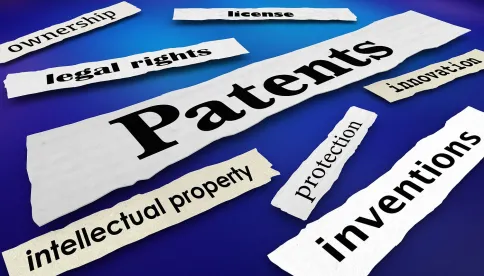The outlines of petitioner estoppel continue to evolve as we hit the ten-year anniversary of the American Invents Act and the introduction of post-grant proceedings. Many district courts have wrestled with the scope of estoppel under 35 U.S.C. § 315(e) for an invalidity ground in litigation that petitioner “raised or reasonably could have raised” in a prior AIA post-grant proceeding, but the term “ground” has also created controversy.[1]
Disputes over the meaning of “ground” most often arise where a petitioner asserts patents and printed publications describing a prior art device in an inter partes review (“IPR”), and then seeks to assert the device itself as a basis for invalidity in district court. In seeking to avoid § 315(e) estoppel, petitioners typically argue that devices cannot be asserted in an IPR, which is limited to patents and printed publications, and thus estoppel cannot apply. Patent owners typically argue that § 315(e) statutorily estops petitioners from maintaining in district court invalidity theories that it raised or could have raised in the IPR, including device-based invalidity theories that are patent or printed publication invalidity theories in disguise. Courts have not been uniform in their interpretation of “ground,” with some siding with the patent owner view and others siding with the petitioner view.
What is a “Ground”?
The statute does not define the term “ground.” Is it the specific form of the reference? Or is it the substance of the reference? If the latter, i.e., the substance of the reference, then asserting a device as prior art in district court litigation may be estopped when a publication describing that device was asserted (or reasonably could have been) in an IPR. If the former, i.e., the specific form of the reference, then a device-based prior art argument raised in district court litigation may not be estopped even if a patent or printed publication describing the device or its operation was previously raised in an IPR.
As the district court noted in Medline Indus. v. C.R. Bard, Inc., 2020 U.S. Dist. LEXIS 167052 (N.D. Ill. Sept. 14, 2020):
“The contours of IPR estoppel are hard to define,” Milwaukee Elec. Tool Corp. v. Snap-On Inc., No. 14-CV-1296-JPS, 2017 U.S. Dist. LEXIS 168504, 2017 WL 4570787, at *5 (E.D. Wis. Oct. 12, 2017), “particularly in circumstances where prior art theories in litigation supposedly involve prior art that is not a patent or printed publication,” SPEX Techs. Inc v. Kingston Tech. Corp., No. SACV 16-01790 JVS (AGRx), 2020 U.S. Dist. LEXIS 139105, 2020 WL 4342254, at *14 (C.D. Cal. June 16, 2020) [.]
Id. at *8-9 (emphasis added).
Federal Circuit
There is little guidance from the Federal Circuit on how “ground” should be interpreted. “Neither the Supreme Court nor the Federal Circuit has squarely addressed the issue before the Court, and district courts that have addressed this issue (or a similar one) have come to various conclusions.” Id. at *9.
However, In re DMF, Inc., 2021 U.S. App. LEXIS 27280 (Fed. Cir. Sept. 9, 2021) (unpublished) touches on the issue and appears to come down on the “substance” side. DMF filed a petition for a writ of mandamus challenging the district court’s ruling that AMP Plus, Inc., d/b/a ELCO Lighting (“ELCO”) was not statutorily estopped from raising a ground of invalidity based on a device.
ELCO asserted unpatentability in an IPR based on, inter alia, a published catalog (printed publication). In the district court litigation, ELCO argued invalidity premised on a boating light product sold under the name Hatteras featured in the product catalog. The PTAB issued a Final Written Decision that ELCO had not proved that all the challenged claims were unpatentable. DMF then moved to bar ELCO from asserting invalidity in the litigation based on the Hatteras product itself. Id. at *2.
The district court analyzed whether there was a substantive difference between the product and the description of the product. Id. at *3. The district court determined that there was a substantive difference: the catalog could not anticipate the claims “because ELCO’s invalidity contentions mixed and matched components from various products disclosed in the catalog[.]” Id. “[A]nticipation arguments based solely on the Hatteras product were substantively, germanely different.” Id. “The court added that ELCO was relying on the physical product as a reference for various limitations because the descriptions in the … catalog did not disclose all of the Hatteras product’s features.” Id.
While the district court declined to apply estoppel, its analysis relied upon whether the substance of the invalidity arguments was the same. The Federal Circuit found that the “heavy burden” of a mandamus remedy was not met. Id. at *4.
District Courts
At the district court level, cases continue to line up supporting both definitions of “ground” as we see below looking at district court decisions in just 2020 and 2021:
Cases finding “ground” requires analysis of substance:
-
Spex Techs. v. Kingston Tech. Corp., 2020 U.S. Dist. LEXIS 139105, at *43 (C.D. Cal. June 16, 2020)
-
-
“Kingston relies on a collection of documents, apparently including some documents that are printed publications and some that are not, to support its system invalidity theories. The Court finds that the reliance on some printed publications in an overall collection of documents being used to describe a system invalidity theory should not lead to estoppel of the overall system invalidity theory itself, nor piecemeal exclusion of the printed publications underlying that system invalidity theory, absent a showing that the system invalidity theory is a patent or printed publication theory in disguise.”
-
No estoppel.
-
-
-
Wasica Finance GmbH v. Schrader Int’l, 432 F. Supp. 3d 448, 454 (D. Del. January 14, 2020)
-
-
“[E]vidence is a distinct concept from ‘ground,’ and the statute estops Schrader from proceeding on the Oselin-related ‘grounds’ of invalidity even though the specific evidentiary basis (the ZR-1 Sensors themselves, as opposed to the Siuru printed publication disclosing those sensors) on which Schrader now proceeds was unavailable in the IPR.”
-
Estoppel.
-
-
-
Contour IP Holding, LLC v. GoPro, Inc., 2020 U.S. Dist. LEXIS 4645, at *16-17 (N.D. Cal. January 9, 2020)
-
-
“I agree with GoPro that it is not estopped from relying on the GoPro HD Motorsports HERO video camera and Boland, Exhibit A4/B4. … GoPro avers that the product itself has functionality that was not reflected in the GoPro Sales Catalog used during IPR. Id. at 14-15. As long as this is true, GoPro is not estopped.”
-
No estoppel.
-
-
-
Vaporstream, Inc. v. Snap, Inc., 2020 U.S. Dist. LEXIS 5642, at *64-65 (C.D. Cal. Jan. 13, 2020)
-
-
“[I]f a patent challenge is simply swapping labels for what is otherwise a patent or printed publication invalidity ground in order to ‘cloak’ its prior art ground and ‘skirt’ estoppel,” then § 315(e)(2) estoppel still applies.”
-
Estoppel.
-
-
Cases finding “ground” can be resolved by the form of the reference:
-
CliniComp Int’l, Inc. v. Athenahealth, Inc., 2020 U.S. Dist. LEXIS 224361, at *5-6 (W.D. Tex. October 28, 2020)
-
-
“Estoppel does not extend to other types of prior art, such as prior-art devices. … Therefore defendants can rely on the prior-art systems in their invalidity contentions to argue anticipation or obviousness.”
-
No estoppel.
-
-
-
Medline Indus. v. C.R. Bard, Inc., 2020 U.S. Dist. LEXIS 167052, at Id. at *10-11 and *13-14 (N.D. Ill. Sept. 14, 2020)
-
-
“[A]ny invalidity theory relying upon that product as a prior art reference is not a ‘ground’ that reasonably could have been raised during the IPR. See 35 U.S.C. § 315(e)(2). Section 315(e)(2) similarly does not preclude an invalidity theory that relies upon a document that is not a ‘patent’ or ‘printed publication’ as a prior art reference, even if the document is related to a product. Such a theory also is not a ‘ground’ that could have been used to challenge a patent claim’s validity during an IPR.”
-
“If Congress had wanted to estop an IPR petitioner from pursuing invalidity grounds that relied upon a physical product in a particular situation, such as where a patent or printed publication discloses the same claim limitations as the product, it could have provided language to that effect. Congress did not do so, and this failure indicates that Congress did not intend for the IPR estoppel provision to be that broad.”
-
No estoppel.
-
-
Some of the “form” cases further state that there is no estoppel if the invalidity theory relies on “at least one product or non-patent/non-printed publication even if it also relies upon patents and printed publications that could have been raised in an IPR.” Medline, at *11. See also, Microchip Tech. Inc. v. Aptiv Servs. US LLC, 2020 U.S. Dist. LEXIS 133403, at *12 (D. Del. July 28, 2020) (“[N]othing estops Aptiv from raising invalidity arguments based on a combination of written and physical references.”).
While We Wait for Federal Circuit Interpretation, Will the Proposed Amendments Change Anything? (if passed…)
The proposed amendments to the America Invents Act found in the “Restoring the America Invents Act” bill include changes to 35 U.S.C. § 315(e), such as the time for the application of petitioner estoppel, which would shift from issuance of the Final Written Decision to “after the time for appeal of the decision has expired or any such appeal has terminated.” And an amendment to § 315(c) extends petitioner estoppel to joined parties “to the same extent as if that person, real party in interest, or privy had been the first petitioner in that inter partes review.” The proposed change addressing when petitioner estoppel applies would negatively affect patent owners by delaying application of estoppel until after the IPR appeal is over, which can be a year or more. But the amendments do not provide a definition of “ground” nor do they alter the current language on the scope of estoppel.
Takeaways 2
As patent owner arguing for the application of petitioner estoppel, try to show that the device-based invalidity theory is merely a patent or printed publication theory in disguise. Point out label “swapping” and “cloaking” if the device, system, or product asserted in the litigation is disclosed in a patent or printed publication that was or could have been raised in the IPR. Many courts have noted that even if there is not clear direction from the statute or case law, the appearance of gamesmanship will always raise red flags.
As a petitioner, be aware that prior art devices and related materials asserted in litigation that provide no additional disclosure over patents/printed publications that were raised (or could have been raised) in an IPR may result in estoppel before courts analyzing the “substance” of petitioner’s invalidity positions. Try to emphasize features of the device that were not included in the patents/printed publications. Consider bringing in additional references that may fill in gaps in the IPR positions and distinguish the invalidity position from that asserted in the IPR. And try to avoid any appearance of simple label swapping.
[1]35 U.S.C. § 315(e) ESTOPPEL. —
(1) PROCEEDINGS BEFORE THE OFFICE. — The petitioner in an inter partes review of a claim in a patent under this chapter that results in a final written decision under section 318(a), or the real party in interest or privy of the petitioner, may not request or maintain a proceeding before the Office with respect to that claim on any ground that the petitioner raised or reasonably could have raised during that inter partes review.
(2) CIVIL ACTIONS AND OTHER PROCEEDINGS.—The petitioner in an inter partes review of a claim in a patent under this chapter that results in a final written decision under section 318(a), or the real party in interest or privy of the petitioner, may not assert either in a civil action arising in whole or in part under section 1338 of title 28 or in a proceeding before the International Trade Commission under section 337 of the Tariff Act of 1930 that the claim is invalid on any ground that the petitioner raised or reasonably could have raised during that inter partes review.
Emphasis added. See 35 U.S.C. §325(e) for matching provision relating to post-grant reviews.
[2]Other articles on petitioner estoppel, https://www.finnegan.com/en/insights/blogs/at-the-ptab-blog/delaware-court-applies-skilled-researcher-conducting-a-diligent-search-standard-in-finding-estoppel-under-315e2.html , https://www.finnegan.com/en/insights/blogs/at-the-ptab-blog/speak-now-or-forever-hold-your-peace-avoiding-future-estoppel-challenges.html , https://www.finnegan.com/en/insights/blogs/at-the-ptab-blog/where-are-we-now-are-you-estopped-or-not.html




 />i
/>i

